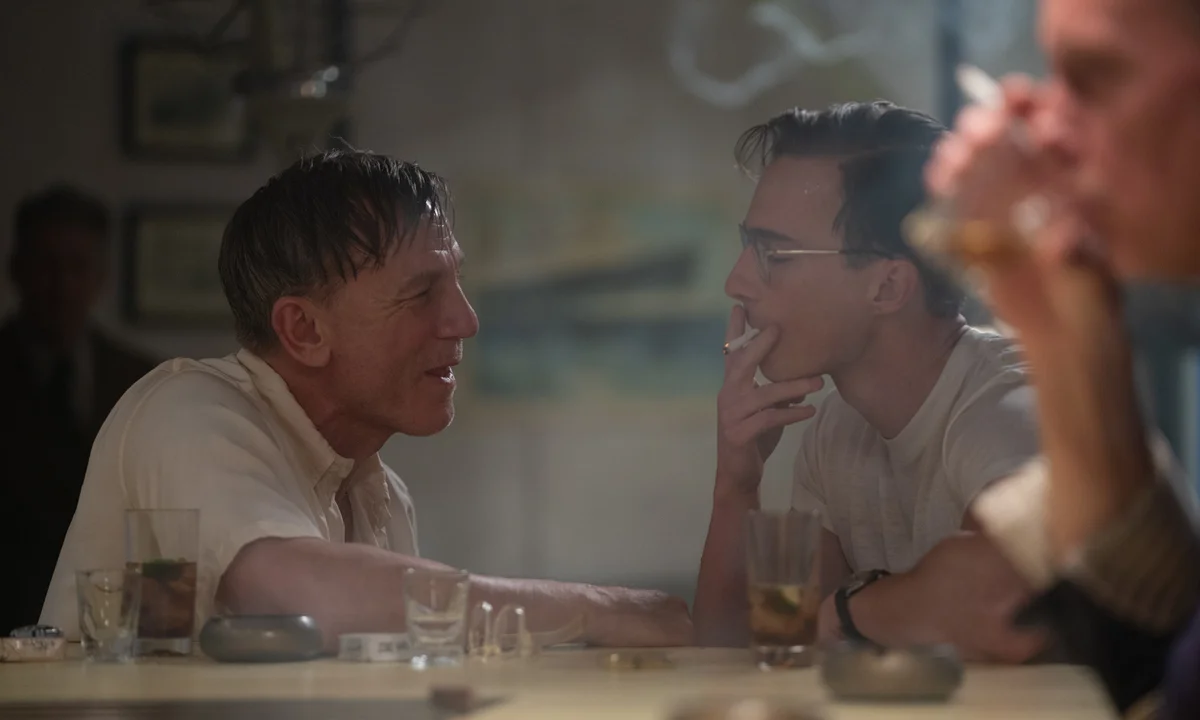Luca Guadagnino delivers a film dripping in style but so carefully designed it lacks the raw human spark that its story deserves.
Queer begins with its opening credits playing over the detritus of its central character’s life. We see the remnants of needles, cameras, and even a centipede pictured against the crinkled white sheets of an unmade bed- it’s all very Tracy Emin. Yet, rather than telling the story of a messy bohemian life, these artefacts feel more concerned with their own beauty as they are orchestrated into a succession of pretty images. The same is true for the film, which tells a choppy, elusive, and painful story of one man but rearranges it into a series of still-life paintings filled with such aching beauty that they drown out the human story which threads them.
The film is based on William S. Burrough’s semi-autobiographical novel of the same name and follows William Lee (Daniel Craig), a 1950s gay American who has travelled to Mexico to live in the relative security he could not find at home. He lives a muted existence, soaking himself in booze at all hours of the day and seeking out men who, for either lust or money, are prepared to accompany him back to a motel room. However, one day, Eugene Allerton (Drew Starkey), a lithe younger man, arrives at their expat enclave and captures Lee’s fascination, sparking new feelings of want and uncertainty. He soon befriends Allerton and, as their relationship grows, attempts to figure out whether his burning passion is reciprocated.
Queer fulfils director Luca Guadagnino’s (Call Me By Your Name, Challengers) own burning passion as he has wanted to adapt Burroughs’ novel since first reading it as a teenager. He even drafted a screenplay, without rights to the film, over 30 years ago but now hands writing duties over to Justin Kuritzkes. This affection is clear in Guadagnino’s slow and deliberate direction, which lingers on moments, luxuriates in lush design work, and fills the screen with a rich colour scheme. He crafts a sumptuous tapestry of a film which, in terms of style, feels worthy of his Italian forbearers like Fellini.

However, this style all comes at a cost as it overwhelms the film. Queer concerns itself with some of the rawest human emotions of yearning, anguish, denial, fear, loathing, self-deceit, and self-destruction. However, it is so neatly manicured that these emotional roots never breakthrough. In the same way that Lee develops mannerisms to protect him from the outside world, so do many of Guadagnino’s directorial choices feel like affectations which keep us from an emotional core. This is particularly true for its many surrealist moments which, for the most part, feel carefully sculpted but ultimately vacuous.
For a film that toys with some of the most primal parts of the human self, Queer is frustratingly fixated with its aesthetic. This is not helped by the decision to film on sound stages in Rome’s famed Cinecitta studios, fulfilling another of Guadagnino’s dreams, which lends the film a very artificial air. This is partly intentional, as the film is intercut with shots of model houses, model aeroplanes, and model cars to create a doll’s house-style effect. However, this all leaves Queer’s world and its inhabitants feeling like a bunch of moving parts to be played around with rather than fully realised entities.
That said, there are some lovely moments to be found amongst all these moving parts, not least in Craig’s performance. Queer’s artifice, combined with the baggage that accompanies an icon of masculinity like Craig playing a gay man, could easily have left his performance feeling like an exercise in Oscar bait. However, he brings a delicate and tender touch to Lee, crafting a nuanced image of a man hidden even to himself. This can be found in the slightest of gestures, including the tentative reaching out of a hand, the odd flamboyant wave, or the musical patter of feet. They all hint at an effervescent individual ensconced within a more traditionally male façade. It is a gorgeous yet painful portrayal of a man trapped in himself.

There are also the occasional tantalising moments where Guadagnino wrangles his style to match Craig’s character work. A sex scene between Lee and Allerton is deftly handled as it succeeds in being beautiful without resorting to sexiness. Instead, it is tender, sloppy and anxious all at once, capturing the potent mix of passion, release, and uncertainty accompanying a first physical connection. The melding of bodies is then taken a step further during a hallucinatory scene which offers an unfiltered look into the abstract heart of human desire.
There is something poignant lurking within Queer’s midsts, which in brief moments is blazoned on the screen. However, for the most part, it is lost amid a sea of style and in a film far too pretty for its own good.
Queer is in Cinemas Now.

